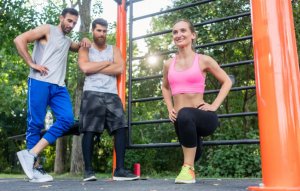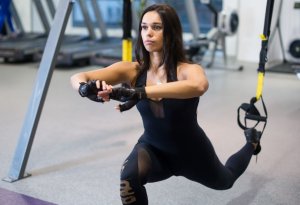Bulgarian Split Squats

Maybe you’ve heard about Bulgarian split squats, but you don’t know how to do them? There are several differences between these and basic squats. Keep reading to learn more!
What are Bulgarian split squats?
With this exercise, you will work your legs, balance and coordination of movement. There are three muscle groups that are activated with Bulgarian squats, and these are:
1. Quadriceps
This area, formed by four different muscles (vast lateral, medial, intermediate and the rectus femoris muscle), is the most powerful area within the entire body, since it allows movement and supports the femur. To work your quadriceps, remove fat and strengthen your knees, Bulgarian squats are ideal.

2. Hamstring
These are located on the backs of the thighs and they are composed of three muscles, including the femoral biceps. They allow for the extension of the hips and knee flexion. The hamstrings are usually in more demand during and for example, running or running a marathon.
3. Hips
The third muscle group that’s improved by doing Bulgarian split squats, are the hips. They guarantee the flexion, extension, and abduction (both when approaching and moving the leg towards the body) of the area.
And of course, we can’t forget the buttocks! They are worked and toned by this movement, and more so, when complemented with a good lower body routine.
How are Bulgarian split squats performed?
Now that you know the areas that they work, next, you need to learn how to do them. You’ll soon notice that there are many differences between basic squats and Bulgarian split squats.
To perform Bulgarian split squats you need a bench, a chair, or even a drawer– any object that will allow you to raise your leg to the height of your knee. Stand with your back to your chosen object, bring your right leg back and support the instep and ankle. The idea is that your leg (from the knee to the foot) is parallel to the ground.
Keeping your back completely straight, bend your left leg and lower your torso as far as you can. The objective of the Bulgarian split squats is to ensure that the right knee doesn’t touch the ground, but it’s very close.
Count to five and slowly return to your starting position. Repeat 10 times before moving to the other side. Once you know the technique well and have enough practice, you can add other elements to increase the difficulty of the exercise. The following list provides some great suggestions:
1. With dumbbells
Take a 2.2 pound dumbbell in one hand and place both arms at your sides. Try to keep your arms as close as possible to your torso, always being careful when lowering into the squat position, so as not to hit your legs.
2. With bar
The bar can be held behind the back (at shoulder height) or above the head (with arms outstretched). It’s a somewhat complex exercise, so you can start with light weights until you establish the balance and coordination that’s needed.
3. With TRX bands
The TRX band is one of the most frequently used pieces of gym equipment, because it allows you to work on various areas of the body- especially coordination and balance.

Instead of resting your leg on a bench, place your instep inside the band that’s hanging from a vertical bar. Then, it’s a matter of performing the same movements that you have already learned.
4. With a kettlebell
This is similar to using dumbbells. You can choose to carry one, or two kettlebells. If you opt for one, you’ll have to change sides with each repetition. This means a repetition with the right hand, another repetition with the left hand and so on.
Maybe you’ve heard about Bulgarian split squats, but you don’t know how to do them? There are several differences between these and basic squats. Keep reading to learn more!
What are Bulgarian split squats?
With this exercise, you will work your legs, balance and coordination of movement. There are three muscle groups that are activated with Bulgarian squats, and these are:
1. Quadriceps
This area, formed by four different muscles (vast lateral, medial, intermediate and the rectus femoris muscle), is the most powerful area within the entire body, since it allows movement and supports the femur. To work your quadriceps, remove fat and strengthen your knees, Bulgarian squats are ideal.

2. Hamstring
These are located on the backs of the thighs and they are composed of three muscles, including the femoral biceps. They allow for the extension of the hips and knee flexion. The hamstrings are usually in more demand during and for example, running or running a marathon.
3. Hips
The third muscle group that’s improved by doing Bulgarian split squats, are the hips. They guarantee the flexion, extension, and abduction (both when approaching and moving the leg towards the body) of the area.
And of course, we can’t forget the buttocks! They are worked and toned by this movement, and more so, when complemented with a good lower body routine.
How are Bulgarian split squats performed?
Now that you know the areas that they work, next, you need to learn how to do them. You’ll soon notice that there are many differences between basic squats and Bulgarian split squats.
To perform Bulgarian split squats you need a bench, a chair, or even a drawer– any object that will allow you to raise your leg to the height of your knee. Stand with your back to your chosen object, bring your right leg back and support the instep and ankle. The idea is that your leg (from the knee to the foot) is parallel to the ground.
Keeping your back completely straight, bend your left leg and lower your torso as far as you can. The objective of the Bulgarian split squats is to ensure that the right knee doesn’t touch the ground, but it’s very close.
Count to five and slowly return to your starting position. Repeat 10 times before moving to the other side. Once you know the technique well and have enough practice, you can add other elements to increase the difficulty of the exercise. The following list provides some great suggestions:
1. With dumbbells
Take a 2.2 pound dumbbell in one hand and place both arms at your sides. Try to keep your arms as close as possible to your torso, always being careful when lowering into the squat position, so as not to hit your legs.
2. With bar
The bar can be held behind the back (at shoulder height) or above the head (with arms outstretched). It’s a somewhat complex exercise, so you can start with light weights until you establish the balance and coordination that’s needed.
3. With TRX bands
The TRX band is one of the most frequently used pieces of gym equipment, because it allows you to work on various areas of the body- especially coordination and balance.

Instead of resting your leg on a bench, place your instep inside the band that’s hanging from a vertical bar. Then, it’s a matter of performing the same movements that you have already learned.
4. With a kettlebell
This is similar to using dumbbells. You can choose to carry one, or two kettlebells. If you opt for one, you’ll have to change sides with each repetition. This means a repetition with the right hand, another repetition with the left hand and so on.
This text is provided for informational purposes only and does not replace consultation with a professional. If in doubt, consult your specialist.








